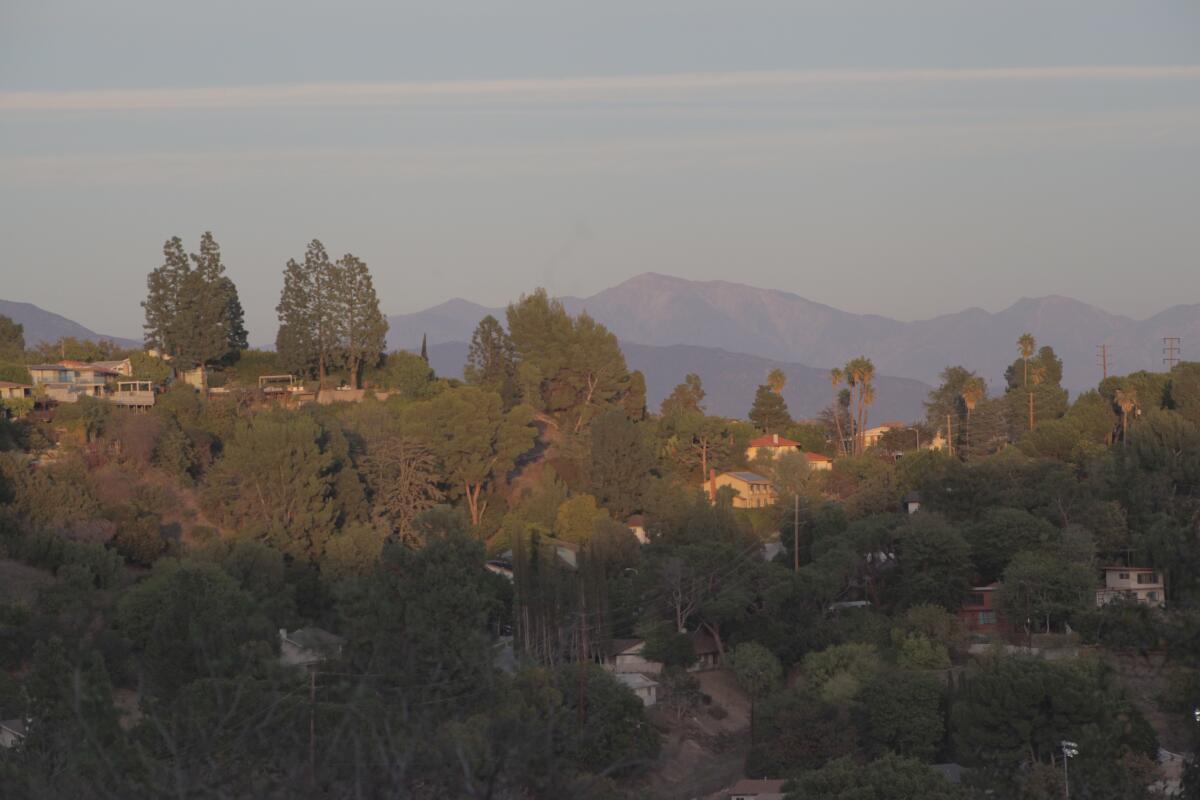I stood atop a lookout point in the heart of Los Angeles County watching the sunset paint downtown L.A. a deep orange.
I was amazed to be alone in the outdoors just before 5 p.m. in America’s second-largest city. I took in more of the panoramic view before me. I could see Mt. Baldy turning a hazy pink as the sun coated the rest of the San Gabriel Mountains in a scarlet hue. I spotted thick clouds moving in over the South Bay. It’d be foggy later.
I’d usually need to travel to Griffith Park or Debs Park for similar views, but that evening’s location was the lesser-known Elephant Hill Open Space, a rolling landscape in El Sereno that local activists hope becomes L.A.’s next great park. But that’s only if they can save it in time.
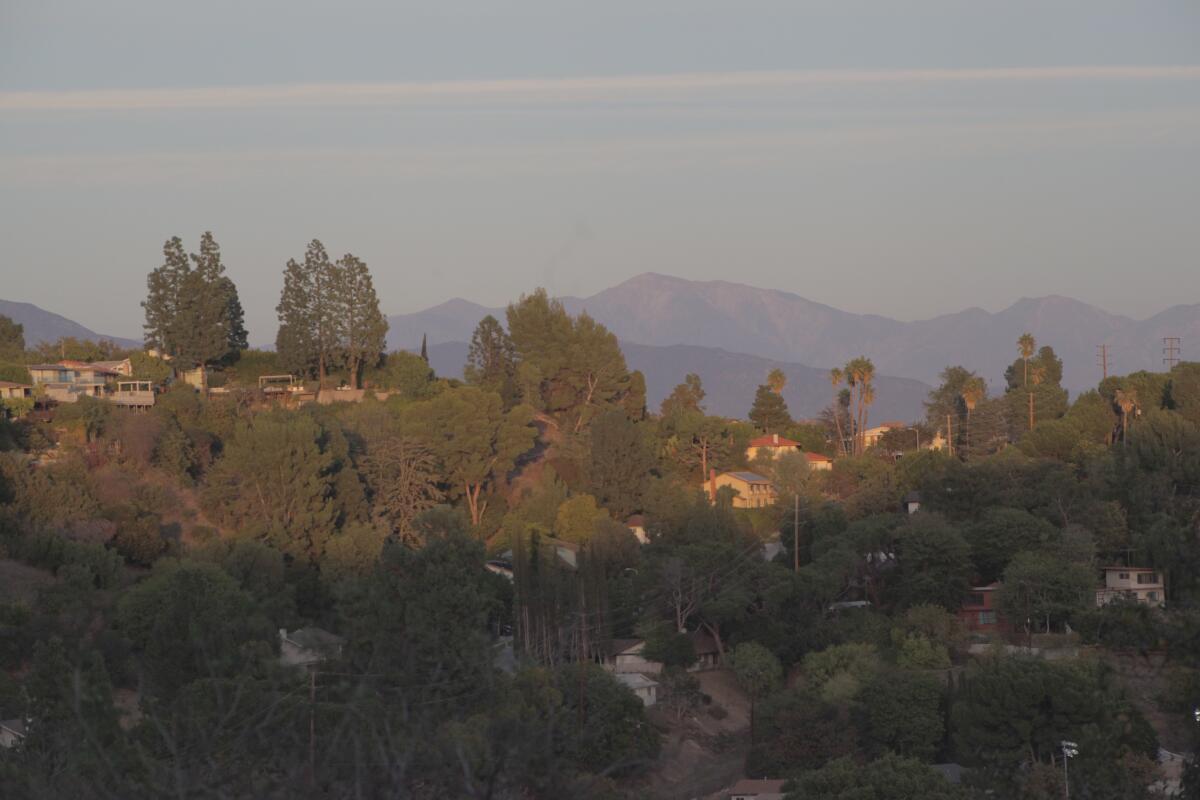
Mt. Baldy is visible in the distance from a hiking trail in Elephant Hill Open Space in El Sereno.
(Jaclyn Cosgrove / Los Angeles Times)
Elephant Hill Open Space is a 110-acre plot of undeveloped land in El Sereno that residents have advocated, for more than 20 years, to be developed into a public park like nearby Debs Park or Ascot Hills with hiking trails, benches and overlook points.
For years, local activists have beat back developers who wanted to build luxury homes, tried to curb illegal dumping and attempted to persuade off-road enthusiasts who have (illegally) carved deep scars into the hillsides to recreate elsewhere.
Their final challenge, though, if the entire 110 acres is to be saved from development, is persuading about 200 different land owners to sell their parcels of Elephant Hill to a public agency — and at fair market rate.
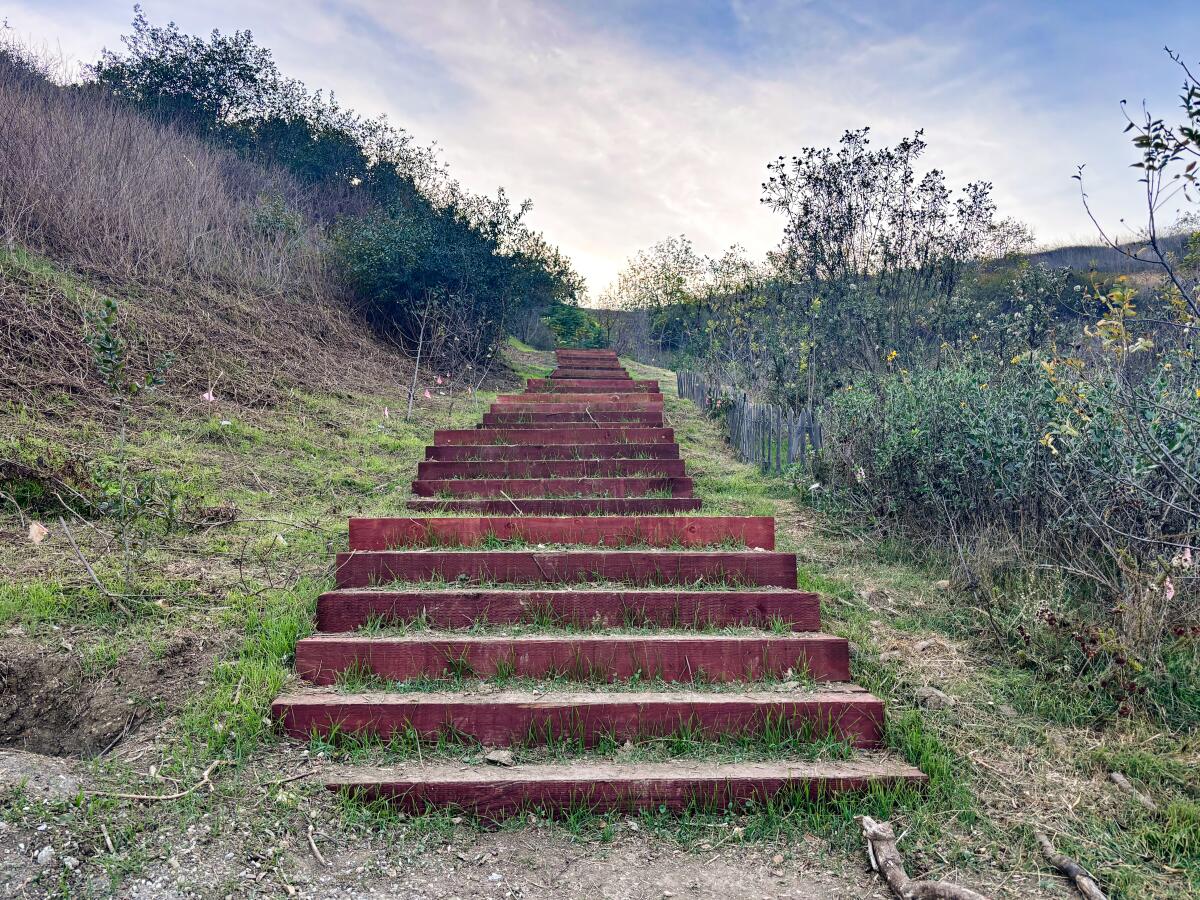
Newly installed steps near the Elephant Hill test plot lead hikers toward panoramic views of L.A. County.
(Jaclyn Cosgrove / Los Angeles Times)
About 25 acres are owned by government agencies. Mountains Recreation & Conservation Authority, a local government agency focused on protecting open spaces, manages 8.37 acres at Elephant Hill and is in the process of buying another 2.4 acres. The city of L.A. owns about 15 acres after buying around 20 acres in a 2009 settlement with a developer who wanted to build luxury homes on the hillsides. (The city later sold five acres to MRCA.)
In recent years, MRCA has received about $4.2 million, including $2 million last month from the Santa Monica Mountains Conservancy, to research and buy more land, build a 0.75-mile trail to bring in more hikers, and install gates and boulders to prevent illegal off-roading.
Sarah Kevorkian, deputy chief of wildfire resilience at MRCA, said her agency is required by law to buy land at fair market rate, making it hard to compete in a “cutthroat” market with private developers who can offer landowners more money.
“The number of individual landowners is an added layer of complexity, and I don’t think that exists in other places, not like this,” Kevorkian said.
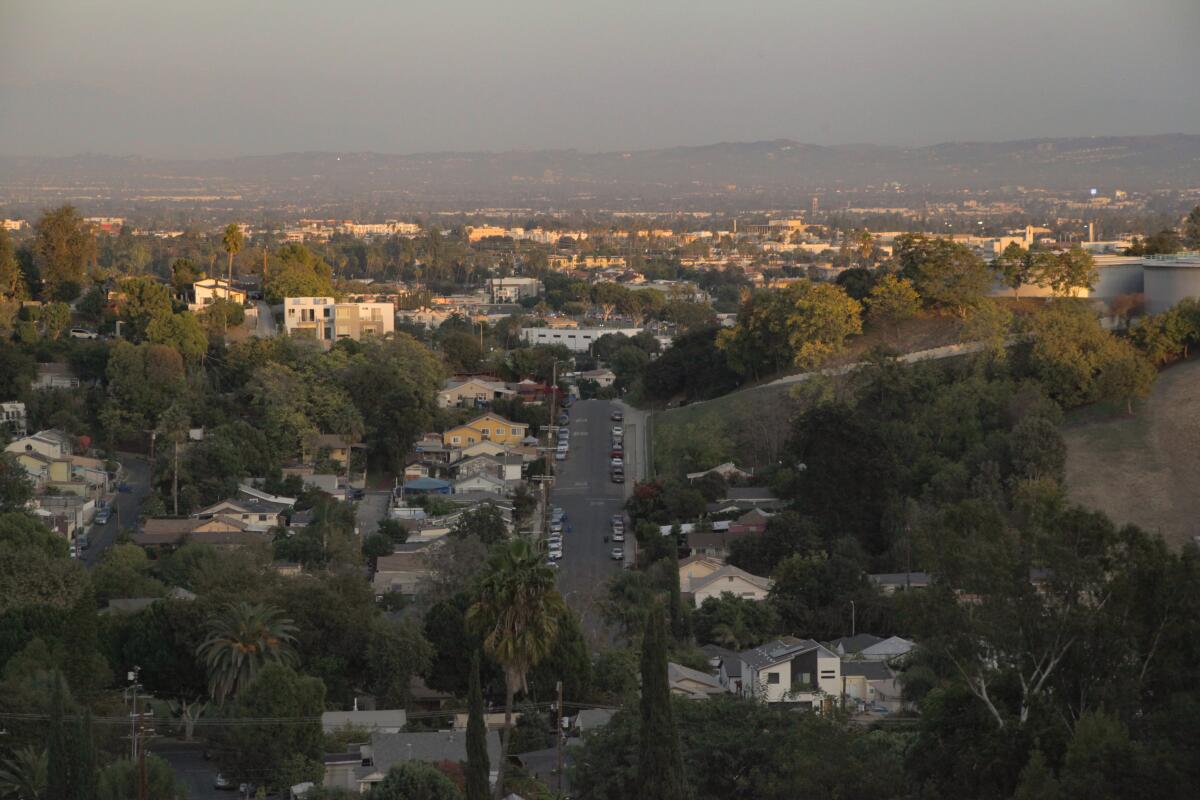
A view looking east from Elephant Hill’s new hiking trail.
(Jaclyn Cosgrove / Los Angeles Times)
Still, she remains optimistic, regularly checking land sales websites to see whether any Elephant Hill owners have posted their properties. Community members are quick to call her if they see a “for sale” sign go up.
“I immediately will call,” Kevorkian said. “I called this one person, and they said, ‘Yeah, we have an offer, we’re going with it.’ … I said, ‘If anything changes, call me back.’ They didn’t, but I just had a feeling.”
The land was next to the hiking trail that MRCA was installing. It’d be such a perfect parcel to snag.
Kevorkian called the property owner back a few weeks later, and they told her the deal had fallen through. “It was such an awesome win,” she said.
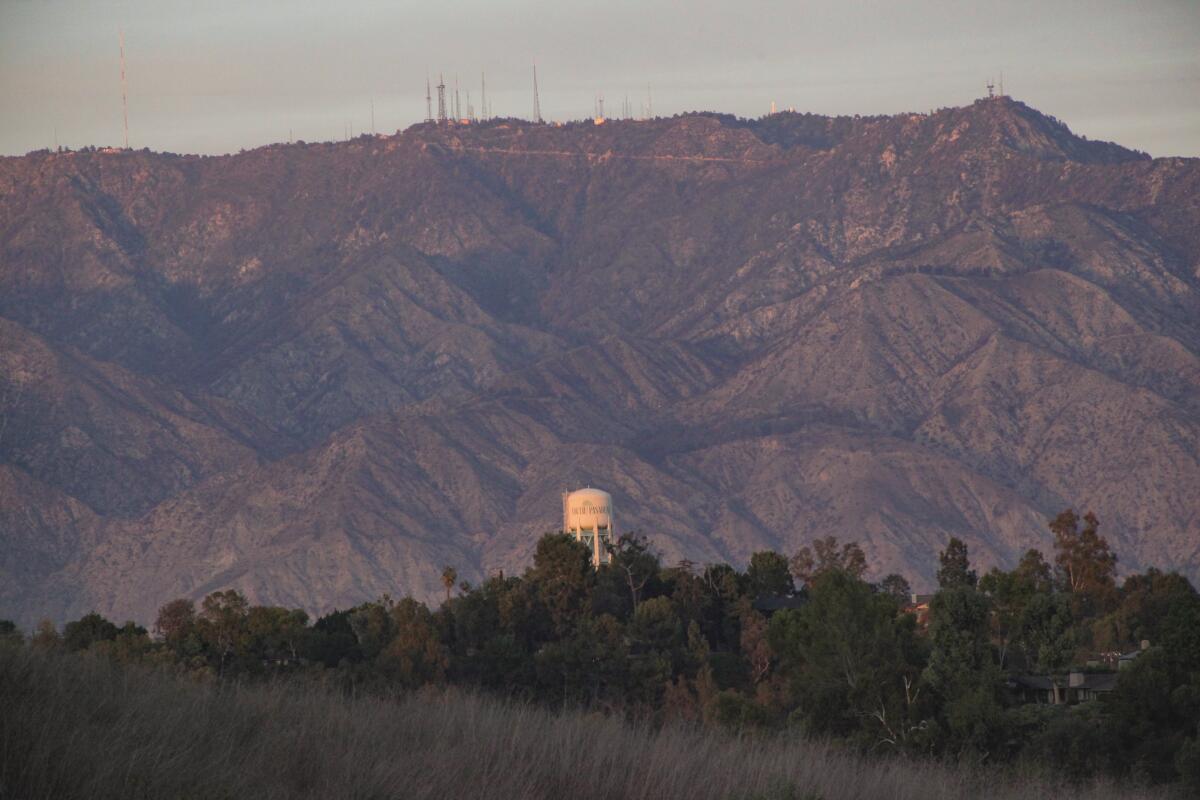
Mt. Wilson is visible from the Elephant Hill Open Space in El Sereno.
(Jaclyn Cosgrove / Los Angeles Times)
And anyone who visits can easily see why.
I first visited Elephant Hill a few weeks ago with Elva Yañez and Hugo Garcia, co-founders of Save Elephant Hill. They started their efforts in late 2003 to try to fight off private developers. Both live within walking distance of the open space.
We started our hike on the western side of Elephant Hill, with an aim of seeing the beginnings of Elephant Hill’s first official hiking trail, which MRCA expects to complete next year with way-finding signage, boulders and more.
We headed up the steep terrain, quickly passing the latest disputed development — a truck garden that’s drawn the ire of Save Elephant Hill and other conservation groups for its owner’s choice to chop down protected native trees, as reported by L.A. Taco.
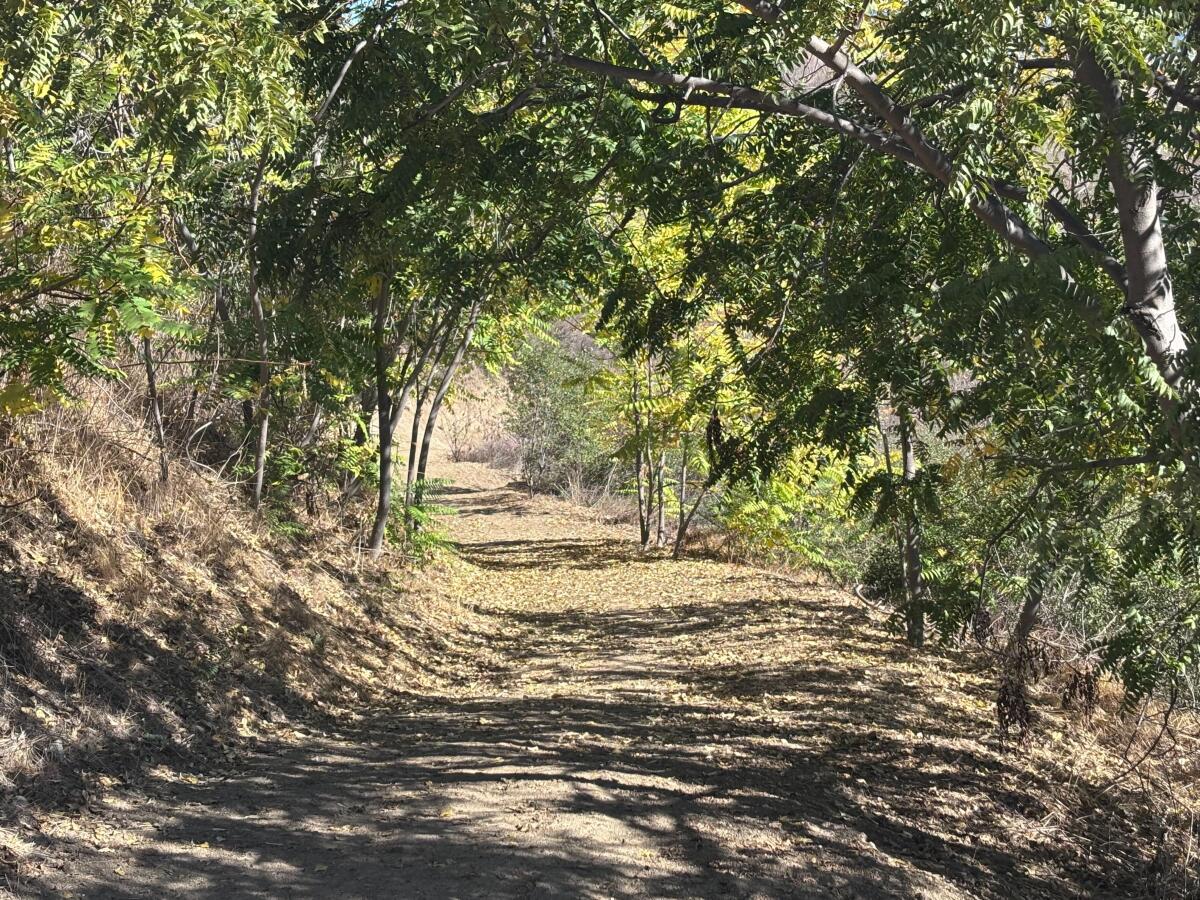
A tree canopy provides shade over the hiking trail in Elephant Hill Open Space in El Sereno.
(Jaclyn Cosgrove / Los Angeles Times)
We took the trail’s switchbacks and then paused to catch our breaths in the shade of hollyleaf cherry, black walnuts and other trees creating a dense canopy. There, the hills blocked the noise from the roads and city. It’d be the perfect place for a picnic table, bench or both.
Next, we walked down newly installed steps to reach the Elephant Hill test plot, a lush experimental restoration garden where volunteers have planted hundreds of native flowers and shrubs and close to 100 trees. The land looks grateful.
Bees buzzed around the sugar bush and coyote brush. Unlike other parts of the park that remain overwhelmed with invasive mustard, trees of heaven and castor bean, this area is thriving with drought-tolerant and, in some cases, fire-resistant native plants.
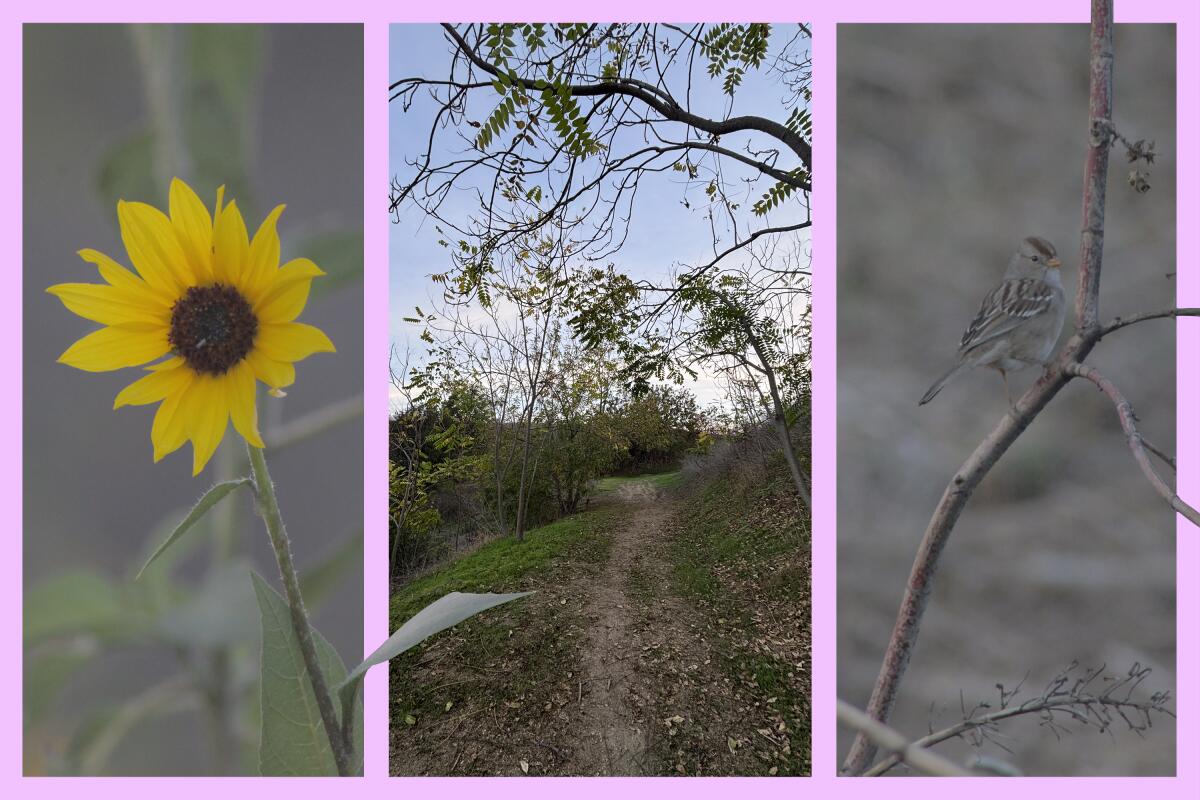
A native sunflower in the test plot garden, from left, a shaded path in Elephant Hill, and a white-crowned sparrow perched in the test plot garden.
(Jaclyn Cosgrove / Los Angeles Times)
Yañez said during the early days of the COVID-19 pandemic, she and Garcia realized they needed to expand their list of allies for Elephant Hill. “We’re not naturalists. We’re not traditional environmentalists. We’re not native plant people,” she said. “We realized at a certain point that we have to activate this space. We have to get people on it to start building that support.”
Joey Farewell, an estate planner who lives nearby and manages the test plot, said, with Yañez and MRCA’s blessing, the test plot volunteers installed the garden in fall 2022 and have seen it thrive, largely without watering outside of what’s needed to first establish new growth.
The test plot started as 3,000 square feet and has expanded to 10,000 square feet of native plant, said Jennifer Toy, director of nonprofit Test Plot, which has 16 experimental gardens around L.A. At Elephant Hill, volunteers have cleared about 20,000 square feet of invasive species, she said.
“It’s not a huge area, but each year we think about” what they can do next, Toy said. “It’s a work in progress.”
And it’s a powerful proof of concept of what Elephant Hill could look like with investment.
Farewell, who is the conservation co-chair of the L.A. and Santa Monica Mountains chapter of the California Native Plants Society, said most people don’t realize what a dynamic landscape Elephant Hill is, including its water features.
“My kids would play by the brook” after heavy rains, Farewell said. “You could reach your hand into one of the springs that fed the stream and feel the water bubbling out of the ground.”
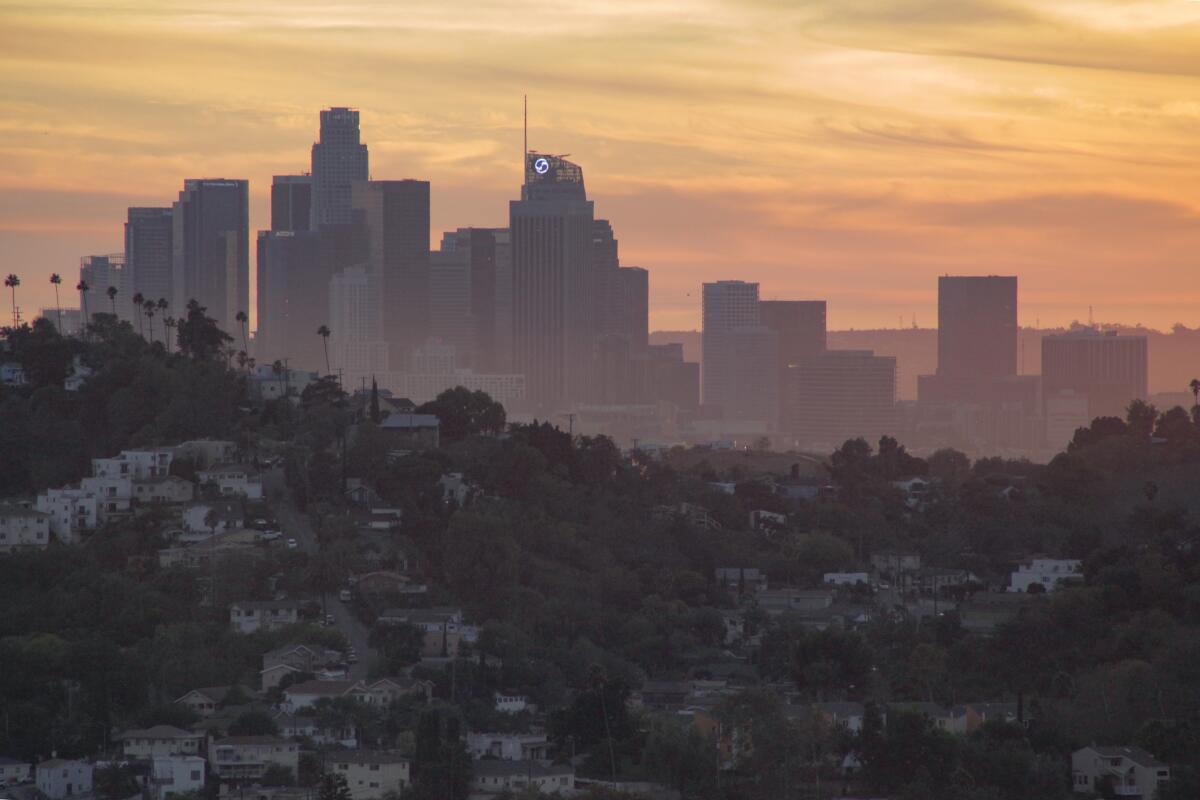
The view of downtown L.A. from a high point at the Elephant Hill Open Space in El Sereno.
(Jaclyn Cosgrove / Los Angeles Times)
Yañez wants more local children to have similar experiences. Elephant Hill sits among a neighborhood plagued by environmental racism, she said. Green space isn’t readily available, but with the development of Elephant Hill into a park, it could be.
Yañez said she understands the need for more housing in L.A., but Elephant Hill has repeatedly proven an unsafe option. In the late 1980s, townhouses in a nearby development started falling into the ground, causing major structural damage. Around 2006, a developer was using a backhoe to build a fence around his property when the heavy machinery fell deep into a spring. Neighbors referred to it as a “sinkhole.”
“When you look at the big picture of climate change and lack of access to park space in communities like El Sereno, it’s kind of a no-brainer — and it’s very difficult to build here. In fact, it’s not safe,” Yañez said. “All the factors come together and make a pretty strong case on their own for conservation. Plus, I think the community deserves access to open space on these hillsides.”

3 things to do
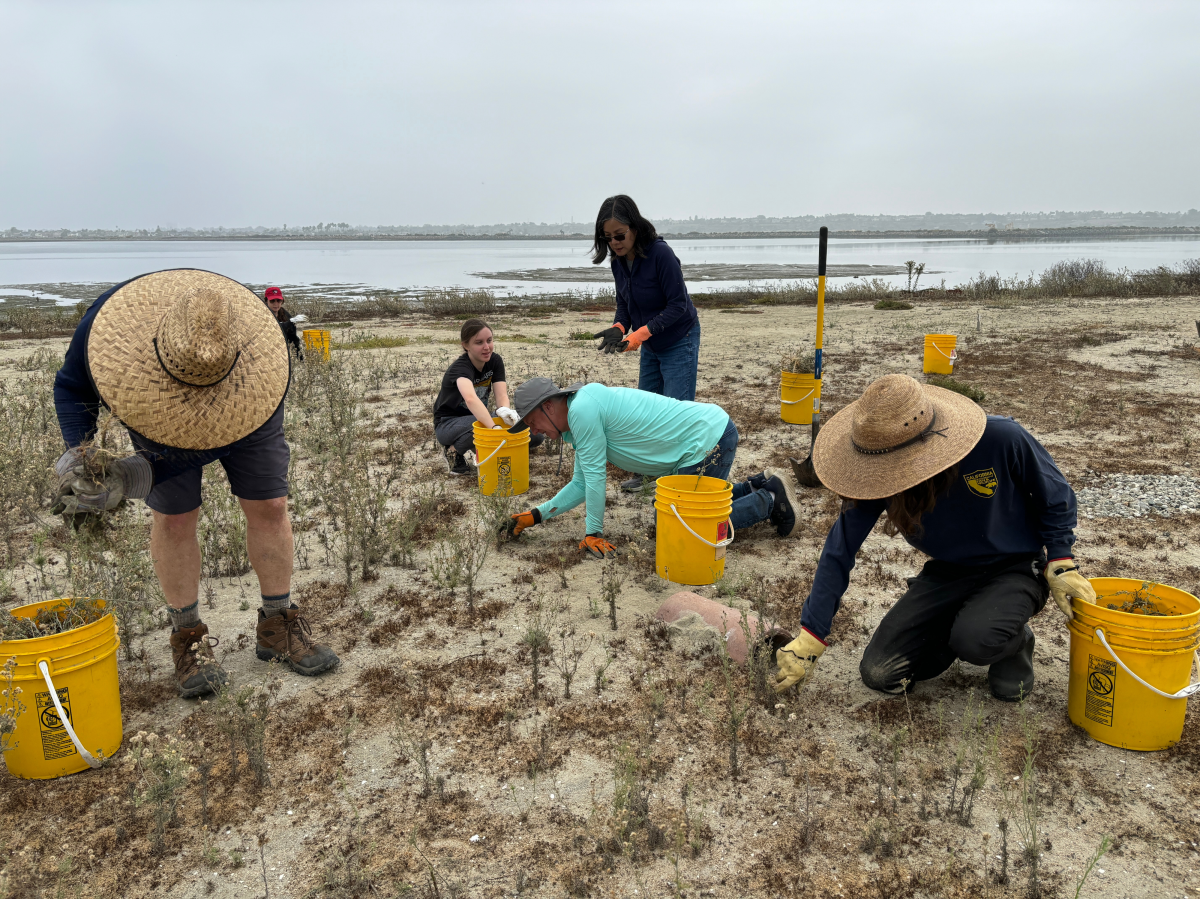
Volunteers repair habitat in the Bolsa Chica Conservancy in Huntington Beach.
(Erika Moe / Amigos de Bolsa Chica)
1. Address messy nests in Huntington Beach
Amigos de Bolsa Chica needs volunteers from 8:15 to 11:30 a.m. Saturday to restore nest habitat for the threatened western snowy plover and endangered California least tern. Participants will remove invasive and overgrown plants in an area of the reserve off-limits to the public. Register at amigosdebolsachica.org.
2. Craft s’mores ’round the campfire in Culver City
The Nature Nexus Institute will host a fall harvest event from 1 to 3 p.m. Saturday at the Baldwin Hills Scenic Overlook featuring a campfire and drum circle. Guests can also take guided nature strolls, listen to storytelling and make s’mores around a campfire. Register at docs.google.com.
3. Nurture native plants in the Hollywood Hills
The Citizens for Los Angeles Wildlife needs volunteers from 9 to 11 a.m. Saturday for a habitat restoration project in the Hollywood Hills. Participants will weed and water young native wildflowers, trees and shrubs, and install humane protection from deer and gophers. Register at clawonline.org.

The must-read
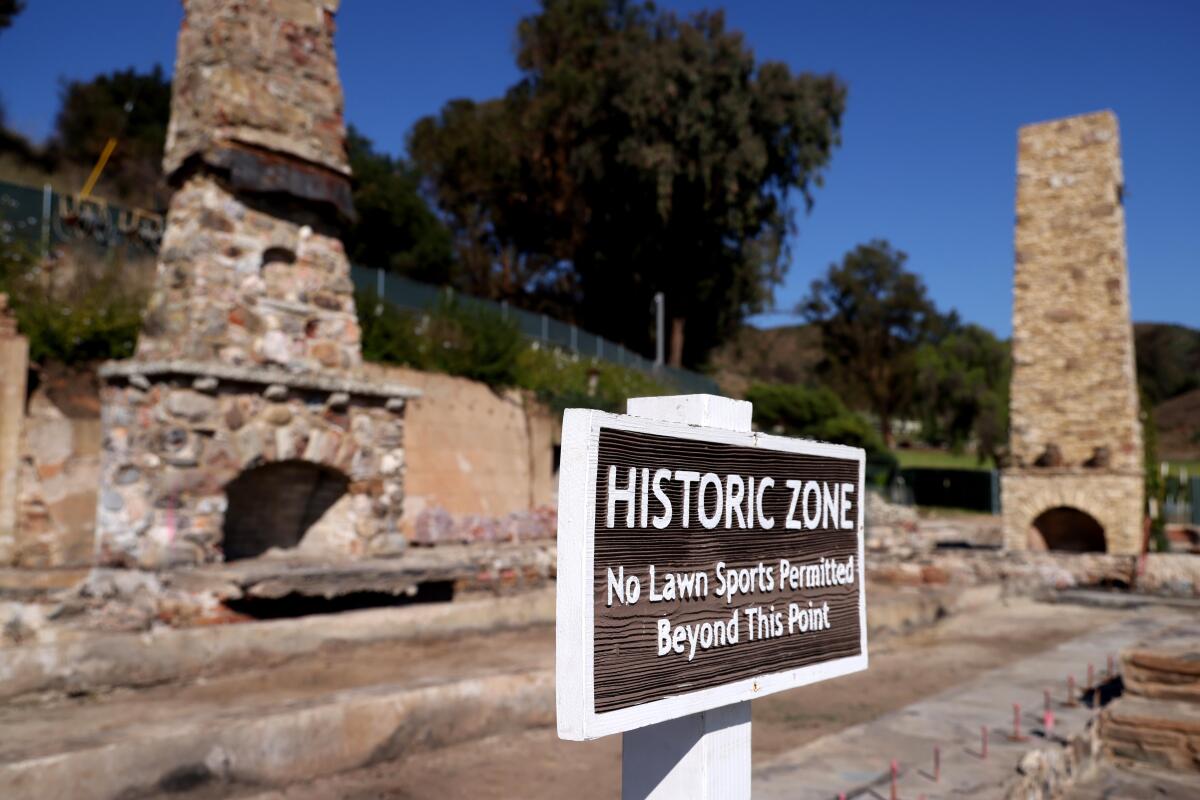
A sign stands in the middle of the fire-ravaged remains of the ranch house at Will Rogers State Historic Park in Pacific Palisades. The park reopened Saturday.
(Genaro Molina / Los Angeles Times)
Hikers rejoice! Will Rogers State Historic Park reopened Saturday after being closed for 10 months following the devastating Palisades fire in January. Times staff writer Hailey Branson-Potts reported that 4.2 miles of the park’s trails are now open while 4.8 miles remain closed. Unfortunately, the segment of the Backbone Trail — a 67-mile trek from Point Mugu State Park to Will Rogers — that runs through the park will remain closed because the fire destroyed the Chicken Ridge Bridge. The Rivas Canyon Trail and Rustic Canyon Trail will also remain closed. The looping trail to Inspiration Point will be partially open, although parks officials might sometimes close it for trail work.
I am glad, slowly but surely, we’re getting to return to some of our favorite places closed by fire.
Happy adventuring,

P.S.
It’s a bird, it’s a plane, it’s — no, it’s a bird! It appears that a bald eagle was spotted flying over the Audubon Center at Debs Park last Thursday. “Could it be?!” the Audobon Center posted on Instagram. The answer is yes, it really could have been! On the citizen science app iNaturalist, users have reported almost 1,000 bald eagle observations in L.A. County, including one over Debs Park in 2017 and others in nearby Glassell Park and Pasadena. Perhaps the Steve Miller Band was correct about our national bird’s flight pattern: “I want to fly like an eagle / To the sea.” May your spirit carry you through this week, friends!
For more insider tips on Southern California’s beaches, trails and parks, check out past editions of The Wild. And to view this newsletter in your browser, click here.
